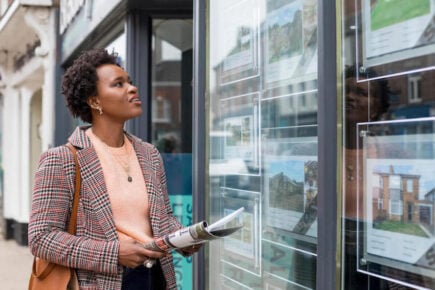Many or all of the products and brands we promote and feature including our ‘Partner Spotlights’ are from our partners who compensate us. However, this does not influence our editorial opinion found in articles, reviews and our ‘Best’ tables. Our opinion is our own. Read more on our methodology here.
Stamp duty is a tax that homebuyers might have to pay when purchasing a property. Stamp duty rates vary according to the value of the property you’re buying and whether you’re a first-time buyer. Sometimes stamp duty doesn’t need to be paid at all.
Read on to learn more about how stamp duty works and how much you might have to pay.
Think carefully before securing other debts against your home. Your home may be repossessed if you do not keep up repayments on a loan or any other debt secured on it
What is stamp duty?
Stamp Duty Land Tax (SDLT), or stamp duty for short, is a tax you pay when buying a residential home or piece of land in England and Northern Ireland.
SDLT also needs to be paid on non-residential property and land, but at different rates.
It applies to both freehold and leasehold properties that you may purchase outright or with a mortgage.
Scotland and Wales have their own versions of property tax, which are similar to stamp duty.
Who pays stamp duty?
Stamp duty is always paid by the person buying the property. Typically, your solicitor, conveyancer or estate agent will file a return to HM Revenue & and Customs (HMRC) and pay any stamp duty on the day of completion on your behalf. They will also claim any tax relief that you might be eligible for.
You’ll have to file the stamp duty return, online or in the post, and pay the tax yourself if they don’t do this for you.
When do you pay stamp duty?
A Stamp Duty Land Tax return should be filed and any tax due should be paid within 14 days of the completion of the property sale.
It’s important to file the return and pay any stamp duty on time, otherwise you may be charged penalties and interest.
You don’t have to submit a return if you’re exempt from paying stamp duty.
How much is stamp duty?
How much stamp duty you pay generally depends on the value of the property you want to buy and whether you are a first-time buyer.
There are different stamp duty rates and thresholds based on how much a property costs.
The location of the property you want to buy also affects how much stamp duty you pay. Scotland and Wales each have their own versions of stamp duty with different rates.
If you’re a first-time buyer, you may qualify for stamp duty relief – if you pay under £425,000 for your first property you won’t pay any stamp duty at all. However, you may have to pay higher rates of stamp duty if you’re buying an additional home.
» MORE: Use our stamp duty calculator
Stamp duty rates in England and Northern Ireland
The table below shows stamp duty rates for buyers in England and Northern Ireland from 23 September 2022.
| Property purchase price | Stamp duty rate |
|---|---|
| Up to £250,000 | 0% |
| £250,001 to £925,000 | 5% |
| £925,001 to £1.5 million | 10% |
| Over £1.5 million | 12% |
Source: Gov.uk
Stamp duty is calculated in a similar way to income tax in that it uses a ‘tiered structure.’
This means the same level of tax isn’t applied to the total property price. Instead, you’ll pay tax on each portion of the property price that falls into the different stamp duty tax bands.
So if you bought a house for £300,000, you would need to pay stamp duty of:
- 0% on the first £250,000 = £0
- 5% on the next £50,000 = £2,500
- Total: £2,500.
In the Autumn Statement 2022, Chancellor Jeremy Hunt announced the nil-rate threshold below which stamp duty isn’t paid will revert to £125,000 with effect from 1 April 2025, the level from which it rose following the mini-budget.
Do you pay stamp duty on a second home?
You’ll usually have to pay 3% on top of the standard stamp duty tax rates if you buy an additional property to your main residence.
If you’re simply moving home and the new property replaces your current main residence, you won’t have to pay the additional 3% stamp duty surcharge. If you purchase your new property before selling your current one then you will be required to pay stamp duty at additional rates. You can then claim a refund if you sell your previous home within 36 months.
Do first-time buyers pay stamp duty?
Since 23 September 2022, first-time buyers in England and Northern Ireland have been exempt from paying stamp duty on properties worth up to £425,000. A rate of 5% is payable on any portion of the property value between £425,001 and £625,000.
There is no first-time buyer stamp duty relief at all for homes priced over £625,000.
In the Autumn Statement 2022, it was announced that from 1 April 2025 the threshold at which first-time buyers don’t have to pay stamp duty will revert from £425,00 back down to £300,000 – the level from which it was increased as part of the mini-budget 2022. At the same time, the maximum value of a property on which first-time buyer stamp duty relief can be claimed will return to £500,000 from £625,000.
» MORE: How first-time buyer stamp duty relief works
Stamp duty exemptions
Some buyers may be exempt from stamp duty, which means they don’t have to pay or file a return. You may be exempt from stamp duty if:
- the property is worth less than £40,000
- property is left to you in a will
- property is transferred to you in a divorce or dissolution of a civil partnership
- you use alternative financial property agreements
Can stamp duty be claimed back?
You can apply for a stamp duty refund if you think you have overpaid.
HMRC usually issues the refund first and checks whether the claim is accurate afterwards. It can take HMRC up to nine months to check your refund is accurate and make changes.
If HMRC finds that you claimed the wrong amount or weren’t entitled to a stamp duty refund, you will have to repay the money, plus interest. You may also have to pay a penalty.
For this reason, you may not want to use the money until you have confirmation that your refund is correct.
Stamp duty relief
There are certain situations, other than being a first-time buyer, when stamp duty relief might also be available. You could also get a stamp duty discount for:
- multiple dwellings
- right to buy properties
- registered social landlords
- charities buying for charitable purposes
You can find a full list of stamp duty reliefs on Gov.uk.
Stamp duty in Scotland
In Scotland, you may need to pay Land and Buildings Transaction Tax (LBTT) instead of stamp duty when you buy a home.
The table below shows LBTT rates for buyers in Scotland from 1 April 2021.
| Property purchase price | LBTT rate |
|---|---|
| Up to £145,000 | 0% |
| £145,001 to £250,000 | 2% |
| £250,001 to £325,000 | 5% |
| £325,001 to £750,000 | 10% |
| Over £750,000 | 12% |
Source: Gov.Scot
If you buy an additional property worth over £40,000, you’ll also have to pay the Additional Dwelling Supplement (ADS). ADS is charged at 6% of the total purchase price of the property if you entered the transaction on or after 16 December 2022. The previous rate of 4% is payable on transactions that commenced prior to this date.
First-time buyers in Scotland don’t pay LBTT when buying a property worth less than £175,000.
Stamp duty in Wales
If you buy a property in Wales, you may need to pay Land Transaction Tax (LTT).
The table below shows the LTT rates for buyers in Wales that have been in place since 10 October 2022.
| Property purchase price | LTT rate |
|---|---|
| Up to £225,000 | 0% |
| £225,001 - £400,000 | 6% |
| £400,001 - £750,000 | 7.5% |
| £750,001 - £1.5 million | 10% |
| Over £1.5 million | 12% |
Information from Gov.Wales
There is no separate stamp duty tax relief for first-time buyers in Wales. You may also have to pay higher LTT rates if you buy an additional home.
What was the stamp duty holiday?
The stamp duty holiday was introduced on 8 July 2020 to boost confidence in the UK property market after the first lockdown due to Covid-19.
It introduced reduced stamp duty rates, which meant that buyers didn’t have to pay tax on properties worth up to £500,000. The threshold increase meant that buyers could save up to £15,000 when purchasing homes costing over £500,000.
Although it was originally due to end on 30 June 2021, the government extended the stamp duty holiday to the end of September 2021 at a reduced rate.
From 1 July 2021 until 30 September 2021, buyers purchasing a property worth £250,000 or less didn’t have to pay stamp duty.
Image source: Getty Images

Mortgage Rate Cuts May Stall After Inflation Holds Firm
The base rate could remain unchanged for a while and slow down mortgage rate cuts after the latest official data revealed inflation is unexpectedly ‘sticky’. Here are our latest mortgage rate predictions.

More Mortgage Rate Cuts Possible After Surprise Inflation Drop
There are hopes that more mortgage rate cuts may be on the way after a base rate rise that was expected never happened and if competition among lenders for borrowers intensifies. Here are our latest mortgage rate predictions.





